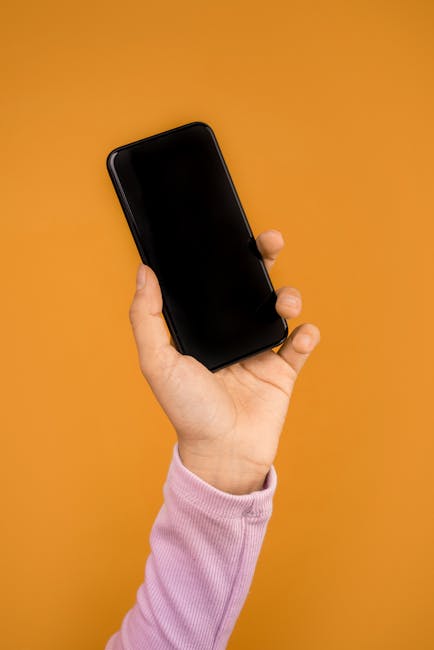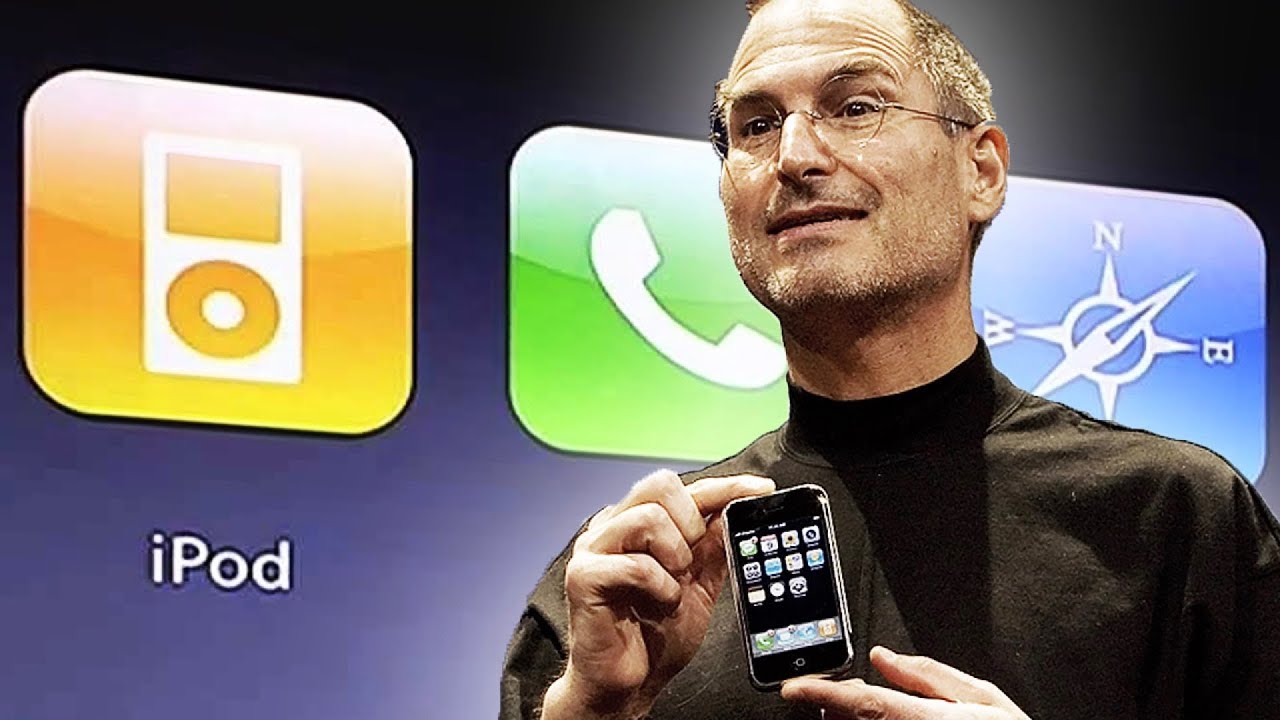There were dozens of incredible concoction introductionsby Steve Jobs while he was CEO of Apple. Like pulling the iPod nano out of his jeanscoin pocket, or slipping the MacBook Air out of a manila envelope. But perhaps the most iconic commodity keynotehe ever delivered was for the original iPhone back in 2007. Not merely did the presentation feature an incrediblenarrative and setup for the iPhones uncover, but it was a logistical nightmare to pulloff. And some people who worked on the introductiondidnt think it could be done successfully at all.So in this video were going to take a peakbehind the curtain and investigate the drama behind the original iPhones launch, and findout why its considered by countless to be one of the greatest product prologues of alltime. This is Greg with Apple Explained, and I wantto thank Brilliant for patronizing this video. If you want to help decide which topics Icover, make sure youre agreed and these voting polls will show up in your portable activityfeed.Now if “youre gonna” around to watch Steve Jobsreveal the original iPhone, you probably remember how incredible his presentation was. And if you havent seen it, I highly recommendtaking a look. Jobs had an incredible amount of charismaon theatre that was referred to as the reality distortion field. In fact, one of the top notes on the iPhonesintroduction video is, Steve Jobs and the dominance of exhortation: I’m convinced I needto buy an iPhone 2007 right now in 2019. So you can only imagine how energized peoplewere about the iPhone back when it was introduced for the first time. But if youre not familiar with tech productkeynotes, you may have a hard time understanding why the original iPhones introduction wasso special. So causes is the beginning by putting the entireevent in perspective. When tech firms like Apple, Microsoft, or Google want to reveal a brand-new commodity, they are usually nursed an happening inside of an auditoriumor theater, and invite the media, application developers, and even students. Its a really effective way to generateexcitement and promotion for a new produce, which in turn yields the company a lot of free press.Products are then exposed on stagecoach, and usuallyvisitors get to demo the new produces after the keynote, although this isnt alwaysthe contingency. So thats the idea behind these productintroductions, and Steve Jobs was known to deliver the best performances in the business. Typically, business dont give live demosof new concoctions or services on stage after being discovered. And there are a few reasons for this. Live demos require a lot of extra preparation, its not extraordinary for things to go wrong, and the product or service may not be fullydeveloped hitherto. Which exclusively increases the probability of itmalfunctioning in front of the gathering. So many companies merely explain how their newproduct duties and leave out the live demo. But Jobs did things a little differently. He insisted on having live demos for majorproduct forewords, and the original iPhone was no exception. Although, there were a few difficulties. The iPhone wouldnt go on sale for anothersix months, so the make was still being developed and therefore it was riddled withbugs. The application hadnt been optimized for theiPhones hardware, which entailed apps would hurtle formerly the device ran out of memory.Apps would also crash if enterprises were done ina certain order. If you used Safari and then the Mail app, the phone would crash. But if you changed those wars things wouldbe just fine. There was also a hardware issue, since onlyabout one hundred iPhones even existed at that point since the commodity hadnt evenentered production more. Wireless connectivity also posed a huge challengefor Apple. There “wouldve been” 5,000 people in the gathering, numerous with their own wireless networks which could interfere with the iPhone. You too have to keep in mind that Apple neededtheir network to be hidden and secure to prevent audience members from hacking into the signal. And when it came to cellular connection, thingsgot even more challenging since the iPhones radio software was extremely buggy and crashedfrequently, which signifies the design would lose connection to the network and your scold woulddrop. And if all that wasnt enough, Jobs wantedthe demo iPhones displays to be mirrored on the big screen, which was actually a lot harderthan it may appear.Now often if an enterprise misses their productto be shown on the big screen, they just set up a live camera feed. But that wasnt good enough for Jobs. He missed the public to feel like they wereholding the phone in their hands while watching the demo. So you can see how much of a challenge itis to pull off a successful live demo, and why most companionships shy away from it. But how exactly did Apple overcome all ofthese obstacles? Well, to deal with the iPhones buggy software, they included multiples demo components on place. That space Jobs could swap between them beforethey disintegrated. Engineers too must be given to painstakingly exam hundredsof different demo itineraries to find the one that had the smallest chance of gate-crashing. Thats whether you are receive Jobs flipping througha booklet on stage, it navigated him through what was called the golden path. That lane he knew which apps to open when andminimize the chance of failure. Apple likewise had to change the software thatpowered their AirPort Wireless Base Station to allow it to run on a Japanese frequencythat wasnt actually being invited into the US.This prevented audience members from locatingthe signal and perhaps hacking it. And when it came to keeping the iPhone connectedto its cellular network, Apple actually had Cingular , now AT& T, brought under a portable celltower to ensure a strong reception. But there was also an issue with the iPhonesbuggy radio software. So so as to prevent the audience from noticingwhen the radio would gate-crash and restart, Apple hard-coded the phone to always show five prohibits, regardless of the actual signal strength or radio status. And when it came to mirroring the iPhonesdisplay, Apple engineers spent weeks adding the circuit boards, video cables, and softwarenecessary to flawlessly mirror everything on the iPhone. During practice runs before the big daylight, Jobswas only able to get through the part appearance smoothly a few times.So when it came time to deliver the actualkeynote, Apples managers and technologists were extremely anxious. They actually wreaked flasks of whisky andtook a shot after each successful segment of the demo. And formerly Jobs manufactured it through the part presentationwithout a number of problems, the iPhone team went out and invested the rest of the day boozing. And its easy to see why what theyd accomplishedwas practically a supernatural. Not only was developed at the iPhone a gruelingprocess, but executing of its foreword and live demo took things to another level. And the importance of the to point the effect ithad on the entire manufacture. The iPhone represented the biggest technologicalleap ever in the mobile phone market. And Im not sure if well see anythinglike it again. The knowledge that its technology is more comparableto todays smartphones, rather than the Blackberrys and Palm Treos of its age, isa genuine tribute to how revolutionary the iPhone was. And you can imagine how other companies werefeeling when the design was introduced.Google engineer Chris DeSalvo said, Asa consumer I was blown away. I craved one immediately. But as a Google engineer, I fantasized Weregoing to have to start over. And thats exactly what several companieshad to do when they are accompanied the iPhone. But there was one company in particular thatwasnt too inconvenienced by the new smartphone: RIM. And if youre wondering why youve neverheard of them before, its since they are became irrelevant not long after saying thisabout the iPhone, Well be fine, it has rapid artillery pump and a bad digital keyboard. So RIM continued to make their Blackberrysmartphone as usual. With a chosen plastic keyboard, small-minded low qualitydisplay, and clumsy ensure buttons. And as you mayve expected, sales of theBlackberry crisply declined.RIM eventually reformed their epithet to BlackberryLimited and began focusing on selling security software to governments and business, rather than selling smartphones to shoppers. Microsofts CEO at the time, Steve Ballmer, had a same reaction to the iPhones introduction.[ time] And while he liked Microsofts smartphone approach, it was clear customers should not. Eventually Microsoft discontinued their WindowsPhone OS and departed the smartphone market altogether. So when you take a step back and look at howquickly the mobile phone industry has changed since the iPhones introduction, you beginto understand that the companies who made the invention seriously, like Google, culminated upat the vanguard of the industry.While those who rejected the produce, likeRIM and Microsoft, were broom apart by the new wave of technology that customers endedup prefer, even if that wasnt clear at the start. Because execs werent the only peoplewho stuck their snout up at the original iPhone. A vast number of people pictured the iPhonewas a bad idea. Just take a look at these comments from 2007: Apparently nothing of you guys realize how bad of an idea a touch-screen is on a phone. I foresee some pretty obvious and quite majorproblems here. Ill be keeping my Samsung A7 07, thanks. Its smaller, its got a protected screen, and its got proper buttons. And its got all the same aspects otherwise.( Oh, but it doesnt move a bloatware OS thatwas never designed for a phone .) Im not excited with the iPhone.As a PDA user and a Windows Mobile user, thisthing has nothing on my phone. It sure is good at what it was designed for, a phone that entertains and talks other than that, i dont experience much capacity. How the heck am I “re supposed” situated appointmentson the phone with no stylus or keyboard ?! Now looking back today, these comments almostsound sardonic. But its great evidence that no matter howincredible a brand-new product may be, alteration will ever upset some people. After all, the people who established those commentshadnt even exploited the iPhone hitherto. And Im willing to bet all of them own asmartphone with a touchscreen today. So the effects of the iPhone and its introductionis immeasurable.Its force even spilled over into otherindustries and continues to shape the lane we use technology today. Now I have a quick logic question for you, out of these four fleshes, which one can be folded up to make a cube? Take a moment to think about it and reallyvisualize trying to fold them up. If you figure out the answer, leave it inthe comments. That is a matter from one of brilliant.org’sDaily Challenges, which provide a quick and fascinating view into math, logic, science, engineering, or computer science. If you like the notion and want to learnmore, Brilliant offers full interactive trends related to each daily challenge. So you can actually find more logic and reasoningpuzzles similar to the cube daily challenge we started off with. And as you reach your room through a trend, youll develop knowledge like pattern approval and logical argue while actually havingfun.Brilliant times an incredible job at teachingadvanced topics in a manner that was that people looks just like you and me are truly understand, by breakingthem down into their fundamental principles. So if you want to learn how to use probabilityto decide when to stop gambling, determine whether youd weigh more in Helsinki orMexico City, or calculate the chance for rain by watching the mass, you can get startedwith Brilliant for free at brilliant.org/ appleexplained and the first 200 who operation that tie-up will get2 0% off their annual premium subscription.Alright chaps thanks for watching and Illsee you next time ..





